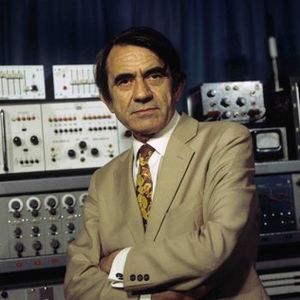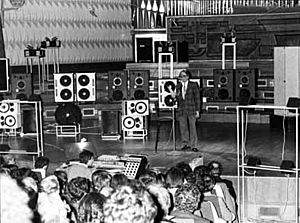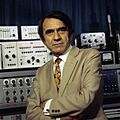Pierre Schaeffer facts for kids
Quick facts for kids
Pierre Schaeffer
|
|
|---|---|

Schaeffer in 1973
|
|
| Born |
Pierre Henri Marie Schaeffer
14 August 1910 |
| Died | 19 August 1995 (aged 85) Aix-en-Provence, Bouches-du-Rhône, France
|
| Occupation | Composer, musician, writer, engineer, professor, broadcaster, acoustician, musicologist, record producer, inventor, entrepreneur, cultural critic |
| Years active | 1942–1990 |
|
Label(s)
|
GRMC/GRM, INA, Phonurgia Nova, Philips, Disques Adès, EMF, Prospective 21e Siècle |
Pierre Henri Marie Schaeffer (born August 14, 1910 – died August 19, 1995) was a French composer, writer, and engineer. He is famous for creating a new type of music called musique concrète. This kind of music uses recorded sounds from the real world, not just traditional instruments.
Schaeffer was a pioneer in electronic music and experimental music. He used new technologies after World War II to create unique sounds. He is seen as one of the most important figures in early electronic music. Many of his ideas, like using recorded sounds and sampling (taking parts of existing recordings), are still used by musicians today.
Contents
Life and Discoveries
Early Life and Education
Pierre Schaeffer was born in Nancy, France, in 1910. His parents were both musicians, but they wanted him to study engineering. So, he went to engineering schools in Paris, finishing his studies in 1934. He earned a diploma in radio broadcasting.
Exploring Sounds with Radio
In 1936, Schaeffer started working at a French radio station called Radiodiffusion Française. This is where he began to mix his engineering skills with his love for sound. He convinced the radio station to let him use their equipment to experiment.
He tried many new things with sounds. He played recordings backwards, slowed them down, sped them up, and mixed them with other sounds. These techniques were very new at the time! He even created some of his own electronic instruments. One important instrument he helped create was the Acousmonium, which used many loudspeakers to play sounds.
Starting a New Music Group
In 1949, Schaeffer met another composer named Pierre Henry. They worked together on many musical pieces. In 1951, Schaeffer started a group called the Groupe de Recherche de Musique Concrète (GRMC). This group had a new studio with a tape recorder. This was a big step because before, Schaeffer had to use phonographs and turntables to make music.
Schaeffer was one of the first composers to make music using magnetic tape. In 1952, he wrote a book called À la Recherche d'une Musique Concrète (which means "In Search of a Concrete Music"). This book explained his new ways of making music.
Teaching and Later Years
From 1968 to 1980, Schaeffer taught at the Paris Conservatoire, a famous music school. He created a special class about music and audiovisuals.
Later in his life, Pierre Schaeffer suffered from a memory illness. He passed away in 1995 at the age of 85. Many of his friends and colleagues called him the "Musician of Sounds" because of his amazing work with sound.
What is Musique Concrète?
The term musique concrète (pronounced "moo-ZEEK kohn-KRET") means "concrete music" in French. Schaeffer came up with this name in 1948.
Normally, music starts with an idea (like musical notes on paper) and then becomes sound. But Schaeffer believed that "concrete music" should start with real, everyday sounds. He would record sounds from the world around him, like train noises, voices, or natural sounds. Then, he would change and arrange these sounds to create a new musical piece.
This type of music broke away from traditional instruments and music rules. Schaeffer wanted to build music from the ground up, using any sound he could find.
Schaeffer's Impact on Music
Pierre Schaeffer's ideas changed music in several ways:
- Using all sounds: He showed that any sound, not just those from musical instruments, could be part of music. He would even change instrument sounds so they sounded unfamiliar.
- Manipulating recordings: He was one of the first to change recorded sounds to make music. He used techniques like tape looping (repeating a sound) and tape splicing (cutting and joining tape). These methods are similar to how people use sound collage today.
- Playing with sound: Schaeffer emphasized the idea of "playing" (jeu in French) with sounds. This means exploring and experimenting with sounds freely, like a game.
His work was a very important step for modern sampling techniques. Today, many music producers, especially in rap music, use everyday sounds and samples to create their songs, just like Schaeffer did.
Musical Works
Pierre Schaeffer's music was recorded on cassettes or magnetic tape before CDs existed. He wanted his music to show people a new and exciting way of making sound. His original works were produced by the "Groupe de Recherches Musicales" (GRM), the group he started.
Here are some of his famous musical works:
- Cinq études de bruits (1948) - This means "Five Noise Studies."
- Symphonie pour un homme seul (1950) - "Symphony for a Single Man," created with Pierre Henry.
- Orphée 53 (1953) - An opera.
- Etude aux objets (1959) - "Study of Objects."
Writings
Schaeffer wrote many books and essays, not just about music. He wrote novels, plays, and articles about his ideas.
Novels and Short Stories
- Chlothar Nicole (1938)
- The Guardian of The Volcano (1969)
Plays
- Tobie (1939)
Non-fiction Books
- Traité des objets musicaux (1966) - "Treatise on Musical Objects," a very important book about his theories.
- In Search of a Concrete Music (1952)
Images for kids
See also
 In Spanish: Pierre Schaeffer para niños
In Spanish: Pierre Schaeffer para niños






